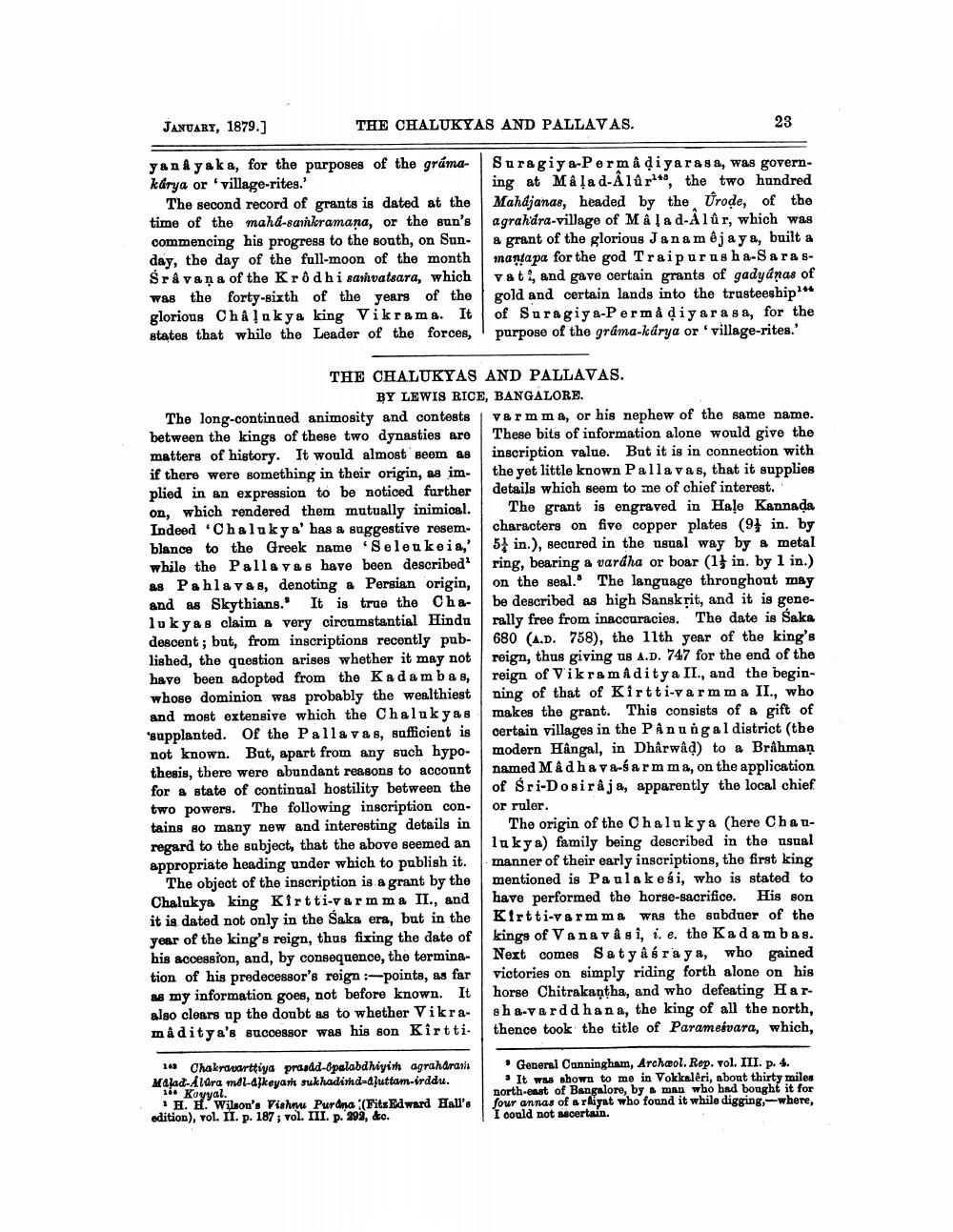________________
THE CHALUKYAS AND PALLAVAS.
JANUARY, 1879.]
yanayaka, for the purposes of the gráma kárya or 'village-rites.'
The second record of grants is dated at the time of the maha-samkramana, or the sun's commencing his progress to the south, on Sunday, the day of the full-moon of the month Sravana of the Krôdhi samvatsara, which was the forty-sixth of the years of the glorious Chalukya king Vikrama. It states that while the Leader of the forces,
THE CHALUKYAS AND PALLAVAS. BY LEWIS RICE, BANGALORE.
The long-continued animosity and contests between the kings of these two dynasties are matters of history. It would almost seem as if there were something in their origin, as implied in an expression to be noticed further on, which rendered them mutually inimical. Indeed Chalukya' has a suggestive resemblance to the Greek name Seleukeia,' while the Pallavas have been described' as Pahlavas, denoting a Persian origin, and as Skythians. It is true the Chalukyas claim a very circumstantial Hindu descent; but, from inscriptions recently published, the question arises whether it may not have been adopted from the Kadambas, whose dominion was probably the wealthiest and most extensive which the Chalukyas 'supplanted. Of the Pallavas, sufficient is not known. But, apart from any such hypothesis, there were abundant reasons to account for a state of continual hostility between the two powers. The following inscription contains so many new and interesting details in regard to the subject, that the above seemed an appropriate heading under which to publish it.
The object of the inscription is a grant by the Chalukya king Kirtti-varmm a II., and it is dated not only in the Saka era, but in the year of the king's reign, thus fixing the date of his accession, and, by consequence, the termination of his predecessor's reign:-points, as far as my information goes, not before known. It also clears up the doubt as to whether Vikramaditya's successor was his son Kirtti
143 Chakravarttiya prasad-6palabdhiyim agraharanis Malad-Alara mel-alkeyam sukhadimd=aluttam-irddu. Kayyal.
H. H. Wilson's Vishnu Purdna (Fits Edward Hall's edition), vol. II. p. 187; vol. III. p. 292, &c.
23
Suragiya-Permâ diyarasa, was governing at Malad-Alûr, the two hundred Mahajanas, headed by the Urode, of the agrahdra-village of M à la d-Alûr, which was a grant of the glorious Janamêjaya, built a mantapa for the god Traipurusha-Sarasvat, and gave certain grants of gadyanas of gold and certain lands into the trusteeship1** of Suragiya-Permà diyarasa, for the purpose of the grama-kárya or 'village-rites.'
varm ma, or his nephew of the same name. These bits of information alone would give the inscription value. But it is in connection with the yet little known Pallavas, that it supplies details which seem to me of chief interest.
The grant is engraved in Hale Kannada characters on five copper plates (9 in. by 5 in.), secured in the usual way by a metal ring, bearing a vardha or boar (1 in. by 1 in.) on the seal. The language throughout may be described as high Sanskrit, and it is generally free from inaccuracies. The date is Saka 680 (A.D. 758), the 11th year of the king's reign, thus giving us A.D. 747 for the end of the reign of Vikramaditya II., and the beginning of that of Kirtti-varmma II., who makes the grant. This consists of a gift of certain villages in the Pânungal district (the modern Hângal, in Dharwad) to a Brahman named M â dha va-sarm ma, on the application of Sri-Dosiraja, apparently the local chief or ruler.
The origin of the Chalukya (here Chauluky a) family being described in the usual manner of their early inscriptions, the first king mentioned is Paulakesi, who is stated to have performed the horse-sacrifice. His son Kirtti-varmma was the subduer of the kings of Vanavasi, i. e. the Kadambas. Next comes Satyasraya, who gained victories on simply riding forth alone on his horse Chitrakantha, and who defeating Harsha-varddhana, the king of all the north, thence took the title of Paramesvara, which,
• General Cunningham, Archæol. Rep. vol. III. p. 4.
It was shown to me in Vokkalêri, about thirty miles north-east of Bangalore, by a man who had bought it for four annas of a riyat who found it while digging,-where, I could not ascertain.




